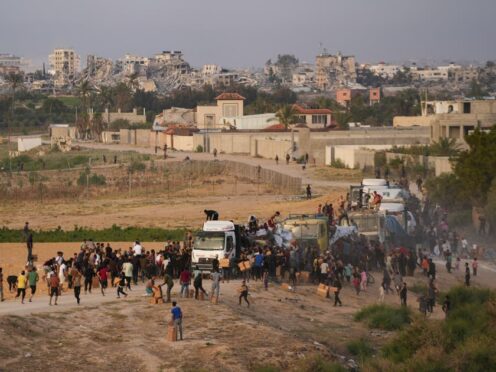
The UN World Food Programme (WFP) said it has handed out a “limited number” of high-energy biscuits that arrived in Gaza via a US-built pier.
It is the first aid from the new humanitarian sea route to reach Palestinians.
WFP spokesman Steve Taravella said on Wednesday the small number of biscuits came in the first shipments unloaded from the pier on Friday.
The US Agency for International Development said 41 trucks loaded with aid from the pier, which cost more than 320 million dollar (£251 million), have reached humanitarian organisations in Gaza.

US national security adviser Jake Sullivan told reporters “aid is flowing” from the pier in response to questions about the troubled launch of deliveries.
“It is not flowing at a rate that any of us are happy with,” he said
Pentagon spokesman Major General Patrick Ryder told reporters on Tuesday he did not believe any of the aid from the pier had reached people in Gaza.
Mr Sullivan said a day later that some aid had been delivered “specifically to the Palestinians who need it”.
American officials hope the pier can bring the equivalent of 150 truckloads of aid to Gaza each day.
That is a fraction of the 600 daily truckloads of food, emergency nutritional treatments and other supplies the United States Agency for International Development (USAID) says are needed to bring people in Gaza back from the start of famine and address the humanitarian crisis brought on by the seven-month-old Israel-Hamas war.
Israeli restrictions on land crossings and a surge in fighting have cut deliveries of food and fuel in Gaza to the lowest levels since the first months of the war, international officials say.
Israel’s takeover of the Rafah border crossing, a key transit point for fuel and supplies for Gaza, has contributed to bringing aid operations near collapse, the UN and relief groups say.
All 2.3 million people of Gaza are struggling to get food, according to aid groups, with the heads of the WFP and USAID having said famine has begun in north Gaza.
The US pier project to bring aid to Gaza via the Mediterranean Sea has had a troubled launch with groups of people overrunning a convoy on Saturday and taking most of the supplies with a man in the crowd shot dead in still-unexplained circumstances.
Saturday’s chaos forced suspension of aid convoys from the pier for two days. Shada Moghraby, the WFP’s spokesperson at the UN, said trucks carrying aid from the pier arrived at a UN warehouse on Tuesday and Wednesday, but it was not clear how many.
The WFP had warned this week that the US project could fail unless Israeli authorities gave clearances and cooperation for alternate land routes and better security.
Humanitarian officials and the US say the sea route is not a replacement for bringing aid through land crossings, and they have repeatedly called on Israel to allow a steady large flow of trucks through entry points and to ensure aid workers are safe from the Israeli military.
Israel insists it puts no restriction on the number of trucks entering Gaza and has blamed a “lack of logistical capabilities and manpower gaps” among aid groups.

Enjoy the convenience of having The Sunday Post delivered as a digital ePaper straight to your smartphone, tablet or computer.
Subscribe for only £5.49 a month and enjoy all the benefits of the printed paper as a digital replica.
Subscribe